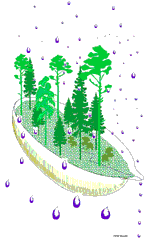
|
||||
 |
|
|||
| Integrated monitoring is conducted in small catchments. A catchment is like a bowl with an ecosystem, where the input and output of pollutants and their impacts on the ecosystem is measured. | ||||
|
In 1979 the UN convention on reduction of Long-Range Transboundary Air Pollution (LRTAP) was ratified within the framework of the UN Commission for Europe (UN ECE). Based on the convention a number of monitoring programmes were started, ”International Cooperative Programmes (ICP:s)”, in order to demonstrate the effects of emission reductions on various biotopes and man-made structures. The programmes target on fresh-water, forest, natural ecosystems (IM), cultivated and wild plants and buildings. A separate programme is devoted to mapping of critical pollutant loads. The information created by the programmes will form a basis for political decisions on further emission reductions if needed. The first agreements were taken at the end of the 1980´s – the so-called sulphur and nitrogen protocols. Subsequently also other substances and impacts have come into focus, such as volatile organic subsatnces, ground ozone, heavy metals, organic pesticides, green-house gases, airborne particles and threats against the biological diversity and depletion of stratospheric ozone. Integrated Monitoring in natural ecosystems (IM) is directed towards creating reliable time series on detailed processes at a limited number of sites rather than geographically covering overviews of Europe. The IM strategy is to
HistoryIn Sweden integrated monitoring of ecosystems (IM) started already in 1981 as part of thenational Programme for Monitoring of Environmental Quality (PMK) run by the Swedish Environmental Protection Agency (SEPA). The PMK programme started in 1978 as a consequence of a parliamentary decision the preceding year. The idea of a national environmental monitoring programme had been discussed for several years prior to the 1978 on the initiative of SEPA. The programme for integrated monitoring in the late 80´s included about fifteen sites more or less completely established all over the country. A few more sites were devoted only to soil and vegetation monitoring.The objective then was to monitor effects of air pollution at sites representative of the physical geographical regions of Sweden. This included both coniferous, deciduous and mixed forest, open mire, lakes and water-courses and alpine and subalpine areas. All were protected from active land-use. IM comprised subprogrammes for chemistry of deposition, soil water, groundwater, runoff water and lake water, soil biology, trees, epiphytes, other vegetation, birds, fish, benthic fauna and lake plankton. At several sites also small rodents, reproduction of fox and organic pesticides were monitored. This broad monitoring continued until about 1994, at which time a new national environmental monitoring programme was launched. Its consequence was that the old PMK-IM sites were abandoned and four new small, hydrologically well delimited sites were established representing different positions in the air pollution gradient of the country. Contrary to the old diverse sites the new ones were homogeneous, dominated by coniferous forest only and contained no lake or large mire. Some of the former subprogrammes were excluded, namely birds, water biology, small rodents, reproduction of fox and organic pesticides. The idea was that the IM programme should more effectively concentrate on the hydrological transport of pollutants through the catchment and biological response in vegetation and soil. On the international level the pilot phase of Integrated Monitoring started in 1989, following the Swedish example. Sweden became ”lead country”, among other things responsible for providing the chairman of IM. All the time Finland has kept responsibility for the international data base and production of reports and other papers from the programme. One of the latter is the IM Manual, describing methods and data reporting procedures. During the Swedish PMK/IM period thirteen sites reported to Helsinki. In 1995 they were reduced to four. Funding and participating institutionsFrom the start the IM programme has been funded by the Swedish Environmental Protection Agency (SEPA). Besides the Department of Aquatic Science and Assessment at SLU also the Swedish Geological Survey (SGU) and the IVL Swedish Environmental Research Institute are involved in integrated monitoring. Each of the parties are responsible for its own data, but IMA has an overall responsibility for coordination and reporting to the international data base in Helsinki. |
